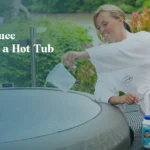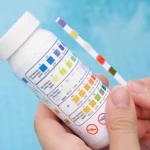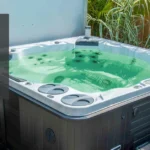Maintaining suitable chlorine levels in your hot tub will determine both comfort and safety.
Although chlorine is a required sanitizer to keep your spa water free from harmful bacteria and clean, too much chlorine can turn your relaxing soak into an unpleasant experience defined by skin irritation, eye irritation, even damage to your swimwear.
Understanding Chlorine’s Purpose
- Active ingredient: The acid actually kills germs
- Primary sanitiser: hot tubs (100–104°F) provide perfect breeding grounds for bacteria
- Chemical process: generates hypochlorous acid when dissolved in water
Chlorine against Bromine
| Aspect | Chlorine | Bromine |
|---|---|---|
| Works | Rapidly | More slowly |
| Effective temperature stability | Less stable at high temps | More stable at high temps |
| Cost | More expensive | — |
| Best use | Shock treatments | Continuous sanitising |
- Danger Zone: Above 3-5 ppm
- Overdose Effects: Equipment damage, discomfort, inadequate sanitation
- Optimal Chlorine Levels: 1-3 ppm
Indices of High Chlorine Concentration
Physical Signs
- Mild stinging to extreme burning
- Redness and inflammation
- Dry, flaking skin
- Eye problems: redness and tears; blurred vision
- Respiration problems: coughing or wheezing; painful throat
Visual and Olfactory Indicators
- Strong chlorine smells suggest chloramines rather than the proper balance
- Constant foam suggests poor filtering
- Fading swimwear or delicate fabrics
- Foggy water despite suitable filtration
Testing Methods
- Liquid test kits give more exact measurements
- Test strips: rapid, simple results
- Digital testers: most exact
- Test multiple criterion minimum two to three times a week
How Should One Naturally Cut Chlorine
Method 1: Water Dilution
Best for: Third through five ppm (Moderate chlorine concentrations)
- Empty 25 to 50 percent of the hot tub water
- Fill it back with fresh water
- Verify levels after mixing
- Repeat if necessary
Method 2: Improved Circulation
Best for: 2–4 ppm (Mild elevation)
- Run jets nonstop for four to six hours
- Remove cover during treatment
- Promotes natural evaporation
- Improves water mixing
Method 3: UV Light Exposure
Best for: Works slowly but forcefully
- Remove cover during daylight hours
- Mix with circulation for best effects
- Track temperature loss
Method 4: Neutralisers Chemicals
For immediate effects:
- Hydrogen peroxide breaks down in oxygen and water
- Thiosulphate, sodium: Expert-grade neutraliser
- Start small initially
- Test periodically to avoid over-correction
Methodical Guide to Reduce Chlorine in Hot Tub
Step 1: Look at Present Values
- Use test strips or digital tester
- Note exact reading of chlorine
- Note pH and alkalinity degrees
- Photograph test results for your records
Step 2: Choose Method Based on Chlorine Level
- 3-4 ppm: Use circulation method
- 4-6 ppm: Use water dilution
- Over 6 ppm: Use chemical neutraliser
Step 3: Apply Chosen Technique
For Water Dilution
- Cut off hot tub power
- Empty 25% of water with drain valve
- Restock with fresh water
- Turn power back on; conduct 30-minute circulation
- Test and repeat if called for
For Chemical Neutraliser
- Calculate required amount as advised
- Add one-fourth of the amount
- Run circulation for 15 minutes
- Examine chlorine concentration
- Add more if needed; keep following process
Step 4: Balance Different Compounds
- Check pH values: ideally 7.2 – 7.6
- Adjust alkalinity: 80 – 120 ppm
- Give 2 hours for circulation
- Retest all four elements
Step 5: Last Check
- Wait 4-6 hours after last change
- Measure pH, alkalinity, and chlorine
- Add maintenance log findings
- Hot tub ready for 1-3 ppm of chlorine
Preventive Activities
Routine Testing
- Before every use: fast test strip check
- Weekly: thorough water testing
- Monthly: professional-grade testing
- Seasonal: whole water analysis
Do’s
- Let flow between additions
- Add chemicals incrementally
- Check before and after adjustments
- Save complete maintenance logs
Don’ts
- Never mix many chemical types
- Never estimate quantities
- Never apply chemicals to stagnant water
- Never add more than 1 tbsp chlorine per 500 gallons at once
Maintenance Tips
- Replace every 3-4 months
- Clean weekly
- Drain every 3-4 months
- Inspect pump and heaters monthly
- Covering maintenance: regular maintenance and inspection
Common Stories Corrected
Myth 1: “More Chlorine = Cleaner Water”
Reality: Chloramines reduce efficacy and cause irritation
Myth 2: “Strong Chlorine Smell = Good Sanitisation”
Reality: Strong smell = poor water balance and chloramines
Myth 3: “Fixed Chemical Schedule Works for Everyone”
Reality: Usage patterns, weather, bather load differ
Myth 4: “Shocking with Large Amounts is Necessary”
Reality: Over-shocking ruins tools, wastes chemicals
Myth 5: “Natural Alternatives Replace Chlorine Completely”
Reality: They supplement, not replace, chemical sanitizers
Enhanced Management Approaches
UV Sterilisation Systems
- 25–50% reduction in chemical use
- Low maintenance; no chemical waste
- UV light kills bacteria and viruses
- Higher cost; bulb replacement needed
Ozone Generators
- Strong oxidiser
- No chemical storage; breaks down pollutants
- Complements chlorine
- Needs expert installation/service
Mineral Purifiers
- Use copper and silver ions
- Reduce chlorine by ~50%
- Natural antiseptic; extended purity
- Slower than chlorine
- May cause discoloration if overdosed
- Frequent cartridge replacement
Automated Systems
- Constant monitoring and correction
- Less manual testing
- Exact chemical management
- Best water balance maintenance
Considerations:
- Significant initial cost
- Calibration and maintenance needed
- Ideal for frequent users
Economic Chlorine Management
- Balanced chemistry maintains equipment
- Maintenance value: prevents costly repairs
- Avoids heater damage, corrosion, electronic failure
- Testing accuracy = proper chemical use
- Balanced approach = lower chemical use
- Quality products = avoid over-treatment waste
- Better chemicals = cost-effective
Environmental Courtesy
- Good balance reduces waste
- Minimize chemical use
- Natural alternatives where possible
- Responsible disposal: let chlorine evaporate before draining
- Water conservation: reuse when maintained well
Eco-Friendly Technologies
- UV/Ozone systems: reduce chemical reliance
- Effective filtration = better water with fewer chemicals
- Smart scheduling = optimise usage patterns
Troubleshooting Reference: Quick Guide
Problem: Chlorine Not Dropping
Possible Reasons:
- Recent shock treatment
- Cold water slows dispersion
- Chlorine source (dispenser, feeder)
Solutions:
- Remove dispensers
- Increase circulation/heating
- Use hydrogen peroxide neutraliser
Problem: Chlorine Drops Too Fast
Possible Causes:
- High bather load
- UV interaction
- Contamination issues
Solutions:
- Test more frequently
- Use consistent chlorine
- Identify contamination sources
Constant Chlorine Odour
Possible Causes:
- Chloramine formation
- Unbalanced water
- Poor circulation
Solutions:
- Shock treatment
- Adjust alkalinity/pH
- Improve flow
Conclusion
Controlling the chlorine level in your hot tub requires a blend of knowledge, consistency, and the right technique. Regular testing is essential to ensure proper water chemistry, while making gradual adjustments helps prevent overcorrections that can throw off balance. It’s always better to prevent issues than to fix them after the fact, and when in doubt, seeking professional help can save time and protect your equipment. Proper care not only ensures a safe and comfortable soaking experience but also extends the life of your hot tub. Every hot tub is unique, so a tailored approach to maintenance is key.




